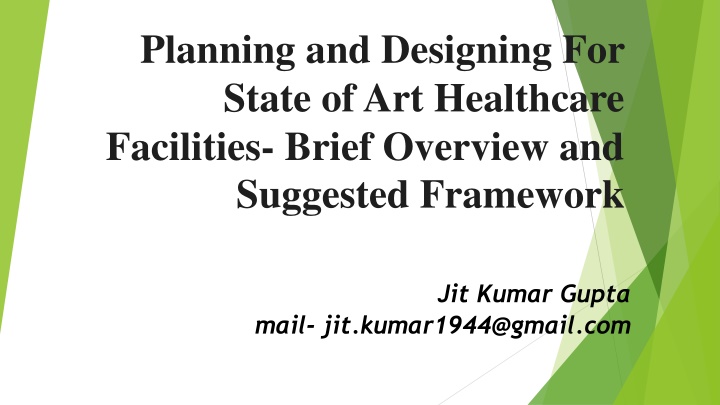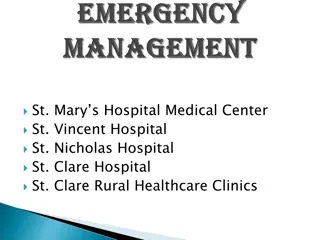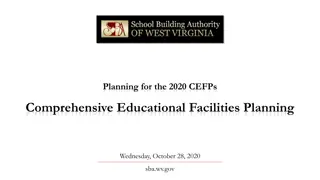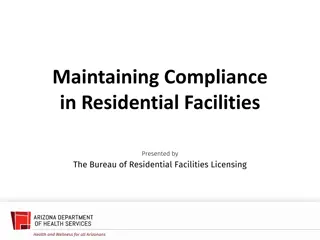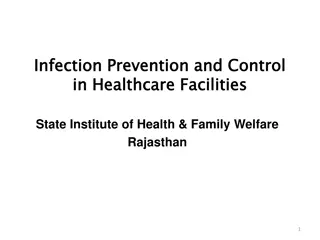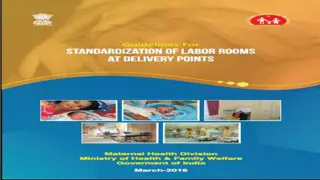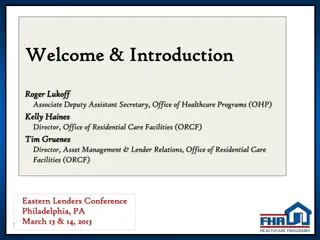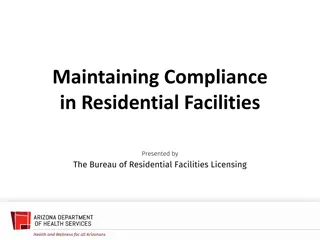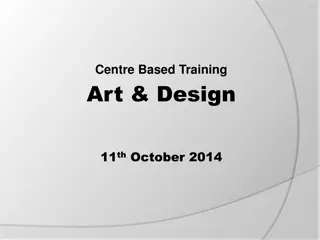State-of-Art Healthcare Facilities Planning Overview
This presentation details the challenges and strategies in planning and designing state-of-the-art healthcare facilities, emphasizing the need for quality manpower and sustainable practices. It discusses the growth of healthcare institutions in India and the importance of preventive care alongside curative measures.
Uploaded on Mar 01, 2025 | 1 Views
Download Presentation

Please find below an Image/Link to download the presentation.
The content on the website is provided AS IS for your information and personal use only. It may not be sold, licensed, or shared on other websites without obtaining consent from the author.If you encounter any issues during the download, it is possible that the publisher has removed the file from their server.
You are allowed to download the files provided on this website for personal or commercial use, subject to the condition that they are used lawfully. All files are the property of their respective owners.
The content on the website is provided AS IS for your information and personal use only. It may not be sold, licensed, or shared on other websites without obtaining consent from the author.
E N D
Presentation Transcript
Planning and Designing For State of Art Healthcare Facilities- Brief Overview and Suggested Framework Jit Kumar Gupta mail- jit.kumar1944@gmail.com
Planning and Designing Healthcare Institutions- Introduction
Planning and Designing of State of Art Healthcare Facilities-Introduction Health-care remains the bona -fide right of every individual Every nation must provide cost-effective, affordable, barrier free, hassle free, qualitative, time efficient and safe, health care for all- of its natives Affordable, timely healthcare remains the greatest challenge for developing / most populated nation having limited resources and with large poverty. Limited trained manpower and affordability pose large road blocks to healthcare With population recorded at 1.21 billion in 2011, India had 1,56,231 Sub Centres, 25,650 PHC and 5,624 CHC on 31st March 2017 -to cater to nation s health needs) . 3,215 Institutions producing 1,29,926 General Nurse Midwives annually and 777 colleges for Pharmacy (Diploma) with an intake capacity of 46795 existed on 31st October, 2017 . 23,582 hospitals having 7,10,761 beds existed in the country-- 19,810 hospitals in rural area with 2,79,588 beds --and 3,772 in Urban area with 4,31,173 beds. Medical education made rapid growth during last 26 years-- 476 medical colleges, 313 Dental Colleges for BDS & 249 Dental Colleges for MD However, limited Architectural/Engineering institutions exist in country for imparting education/expertise in planning, designing , construction of healthcare institutions
Planning and Designing of State of Art Healthcare Facilities-Introduction As per studies made-- India fast becoming most populated country globally -with population of 1.4 billion by 2030 and1.6 billion by the year 2050. Urban population estimated to be 600 million in 2030 and 800 million in 2050 . Considering rapid growth in population/ massive urbanization-- India will need -large number of healthcare institutions across nation, covering all villages /urban centres. . Accordingly well-designed framework, supported by quality manpower ,needs to be prepared-- for creating state of art planned / designed healthcare institutions & to help save enormous resources ; making nation healthy / more productive. All these institutions need to be planned/designed as; -- zero-energy zero-water and zero-waste institution -- to make them not only sustainable - - but also to help in changing the context of healthcare culture -- from Curative to Preventive while acting as wellness centers with focus on human welfare To achieve the objective-- Government should launch specialized courses - for planning, designing, construction / management of Healthcare institutions -- in all IITs/SPAs/NITs/AIMS/ in Healthcare- to create quality resource persons/professionals
Planning and Designing of State of Art Healthcare Facilities- Introduction Presentation is an attempt to; -- define certain basic principles, -- essentials for planning and designing of any -- healthcare institutions. It is hoped, these contents will have some relevance, -- particularly in present scenario of pandemic -- created, locally and globally, by Covid 19 --when well planned healthcare institutions are emerging most valuable entities.
Planning and Designing Healthcare Institutions- Context
Planning and Designing For State of Art Healthcare Facilities- Context Healthcare becoming major priorities for nations to keep people healthy, happy and productive. Healthcare and economical development are known to be positively related. Positive relationship exists between healthcare and productivity Globally spending on healthcare increasing rapidly on yearly basis Higher the development higher becomes the spending Healthcare spaces known for dualities and contradictions- Known as spaces of hope, life ,care, cure, death and disease etc Healthcare as a sector remains integral part of human living, development, growth and decay Healthcare sector remains largely plagued by HAI (Hospital Acquired Infections) Syndrome Growing population/ longevity of life --posing major challenges to providers of quality Healthcare
Planning and Designing For State of Art Healthcare Facilities- Context Healthcare spaces in developing nations suffering from; -- inadequacies --mismanagement --overcrowding of patients -- Overcrowding of visitors - availability in quality and quantity - disintegration - both horizontal and vertical Healthcare sector-- known for creating large stresses and strains-- for both users and stakeholders Healthcare spaces-- generally dreaded by majority of users known to be most inhospitable spaces to visit and treated. Commercialization and entry of corporate sector-- malpractices Healthcare sector suffers from lack of respect/dedication for patients/ visitors/ families Patients treated generally-- as a commodity/object of business -rather than needing support, compassion and care. Segregating patients/ visitors-- both indoor/ outdoor( privacy)-- a major issue / challenge in planning, designing/management in healthcare spaces Healthcare system --has little faith in; -- Reducing cost --Reducing time -- providing quality services brought in numerous unethical
Planning and Designing For State of Art Healthcare Facilities- Context Healthcare consumes lot of productive time of; -- doctor/staff/patients -- for unnecessary travelling --during treatment -- on day to day basis Problem gets compounded; -- in large specialized hospitals -- spread over large area - With departments spread over entire campus - catering to dedicated specialities . Limited work- travel studies made-- to promote operational efficiency of doctors/ nurses/ paramedical staff/supporting staff Healthcare sector-- known for duplication/multiplication of processes/procedures
Planning and Designing For State of Art Healthcare Facilities- Context Healthcare in majority of developing nations suffers from; -- large disconnect between -- treatment provided and -- services required -- lack of well defined systems -- lack of standardization --lack of quality manpower - lack of quality medicine -- quality management -- authentic documentation of; -- rational patient care -- treatment of diseases -- lack of transparency in treatment -- absence of well defined procedures/ processes/systems of healthcare, -- quality treatment and diagnosis etc Healthcare sector suffers from subjectivity. largely driven more by; -- whims /fancies -- of attending / treating doctor /staff -Having minimum accountability
Planning and Designing For State of Art Healthcare Facilities- Context Designing healthcare spaces requires specialized knowledge and expertise. Hospital Design has power to; -- positively impact operational efficiency of hospital - rendering quality services - increasing operational efficiency - minimizing cost of healthcare - curing patients speedily - generating less waste - minimizing operational cost/life cycle cost of built environment Rational Healthcare planning suffering due to; -- Low availability of trained manpower -- having knowledge and understanding of designing hospital spaces Architectural Design brief rarely prepared professionally, leading to; -- emergence of large gaps --between vision &reality --in design /operations of healthcare institutions. Healthcare design generally based on; -- individual approach -- not team based approach leading to; -- mismatch between -- perceived reality and ground reality
Planning and Designing For State of Art Healthcare Facilities- Context Majority of healthcare buildings; -- not rationally designed spaces --leading to operational inefficiencies, -- cost intensiveness, --causing stress for; -- doctors and patients -- making healthcare expensive -- time consuming Majority of designers have; -- little knowledge/experience / understanding of -- complexity of operations of healthcare systems /institutions --leading to creating institutions --able to perform, reform/deliver. Most healthcare spaces designed; -- without much research/ understanding and -- consultation with users /stakeholders
Planning and Designing For State of Art Healthcare Facilities- Context With limited number of institutions; -- imparting dedicated course in -- planning, designing, operation, management / provision --of healthcare services, -- hospital design remains --largely an ignored subject --compared to its role /importance for -- individuals, communities, states/ nations. --Lack of knowledge/understanding of; -- operational / functional domain, - healthcare spaces being designed -- merely as built spaces -- not spaces for healing, care ,love , affection, stress busters, support With privatization/numerous options now being available, -- there has never been need for according a greater priority -- placed on evolving appropriate hospital designs for -- creating safe, clean/ peaceful healing environment Recurring pandemics-Covid 19 -reinforced need/urgency - of creating Quality healthcare spaces to deal with such calamities
Planning and Designing Healthcare Institutions- Issues
Planning and Designing For State of Art Healthcare Facilities- Issues Major issues facing healthcare institutions recognized as; -Quality of Patient care - Management of Patients - Management of Visitors --Quality of services provided - Management of services provided - Managing effectively Core / Peripheral services -- Reducing Cost involved in Healthcare, -Reducing time involved in Patient cure --Addressing Environmental issues, -- Minimizing infection - Managing Waste- Promoting cleanliness - Way finding -Creating Enabling environment -Reducing stress of Healthcare staff/Patients/ Families -- Planning, Designing / Management of hospitals, -Managing traffic-- persons/visitors/patients/Parking Managing /Upkeep of building/services -- Lack of Safety, -- Lack of Security, - Lack of Visibility etc
Planning and Designing For State of Art Healthcare Facilities- Issues High Cost--Healthcare institutions remain intensive- unaffordable for majority of users Quality of services offered- vary to a large extent --remains an issue Time Intensive/time inefficient-In absence of patient care support at home-healthcare always involve lot of time for patient / family/ doctors- with major time used in non-medical procedure Variable Quality of treatment- lack of standardization Stressful Refuge--Healthcare institutions- spaces of stressful refuge Labour Intensive Healthcare a labor-intensive industry- Doctors/staff - highly skilled/ highly paid- accounting for 60 to 75% of hospital expenses High rate of attrition- among healthcare personnel's most cost
Planning and Designing For State of Art Healthcare Facilities- Issues Life-cycle cost- Healthcare cost calculated on short term basis rather than long term-- Resources--Healthcare institutions unsustainable- consuming large resources energy, water, chemicals etc Waste--Healthcare institutions- large generators of waste, large carbon footprints- Healthcare institutions- responsible for generating large carbon footprints Poor waste management -Healthcare generally remain --dirty/filthy Infections--Healthcare spaces Storehouse of infections Generally un-friendly-- Healthcare spaces generally un-friendly to professional patient management Lack of Flexibility--Healthcare demands--High degree of inbuilt / operational flexibility -- for dealing effectively/efficiently with Disasters- manmade/natural largely spaces major
Planning and Designing For State of Art Healthcare Facilities- Issues Quality Literature on designing-- Healthcare largely suffers from absence of quality literature on designing healthcare related spaces Irrational Bye-laws--Limitation imposed by-Rigidity of Local bye-laws/Zoning Regulations-- due to lack of understanding of needs of healthcare buildings Lack of Standardization --Healthcare suffers from lack of standardization Delayed projects- involving cost-overrun/time over- run Low usability of built spaces- with large proportion of built space going under circulation Using large energy Using Conventional source of energy Limited use of Technology Major procedures- both medical/non-medical operated with low efficiency designing processes, --human
Planning and Designing For State of Art Healthcare Facilities- Issues Parking Major vehicles -- Visitors/staff Problem of Way-finding-- for both patients/ visitors- causing delay/wastage of time/ inconvenience Injury suffered to patients- during shifting /movement horizontal/ vertical Mixing of indoor / outdoor patients- public /patients Managing Visitors Quality Patient Management Managing /maintaining public utilities /toilets/public services etc problem of parking
Planning and Designing For State of Art Healthcare Facilities- Issues Involving Families Large involvement/ dependence on families in managing patients- causing congestion/mismanagement Designing / Positioning of wards/operation theatres/doctors/ stations Managing patient related services gasses/equipment etc Sample Testing Taking/Sending sourcing test reports Sourcing Medicines Large involvement of families/visitors in procuring medicines Eating Spaces--Absence of quality eating spaces Time lost in travelling Time lost for Doctors/staff during patient care/ treatment -- due to inappropriate location of essential services/equipment patient nursing samples/
Planning and Designing For State of Art Healthcare Facilities- Issues Disconnect with Nature- poorly planned-- without outside view- creating problems of early recovery Lack of Good Landscape- Plan- Providing/ Creating open spaces- remain low priority within hospitals Poor Daylighting- dingy/poorly lit - creating an atmosphere of depression Poorly designed Indoor Spaces- Bare / barren Interior spaces -- devoid of any art work /colours- create psychological patients/visitors/staff working in hospitals Poor Indoor Air Quality Indoor air quality- rarely monitored in - wards/ patient related area- causingproblems of infections / late recovery Managing Visitors- for reducing pressure on hospital spaces/staff Patient wards - Most hospital spaces issues for
Planning and Designing For State of Art Healthcare Facilities- Issues Poor Signages Way finding for new visitors/patients major issue-- causing undue visitors/patient/staff Lack of Safety/Security- of patients, hospital staff / property -- major issue. Inadequate Public Amenities- quantity/quality/adequacy/positioning-causes concern for visitors/users Limited use of ICT/Tele- Medicine problems of operational inefficiencies --in functioning/operation of healthcare systems -- promoting rush of people/patients visiting -----rational planning /management of patients, -- personnels to be deployed on daily basis. Lack of Planning/placing of essential services in wards- making doctors/staff waste time in duplication of operations/travel Limited Networking- with/within visitors - leading to operational inefficiencies stress on both in undue - Creating hospitals staff/patients/
Planning and Designing Healthcare Institutions- Objectives
Planning and Designing For State of Art Healthcare Facilities- Objectives Whole Building Design Guide ( WBDG) states-- Goal of Architectural Planning & Designing of a state of art healthcare institutions should revolve around-adopting team based integrated approach -for creating, achieving and promoting; -- a successful high performance building -- promoting high accessibility, -- ensuring appropriate aesthetics, -- promoting cost-effectiveness, -- ensuring functional/operational efficiency, -- improving productivity, - ensuring security, -- providing safety and -- promoting sustainability. For Healthcare to be effective/efficient- it must be made ; Human centric/oriented Graduating from Curing to Prevention Acting as Wellness Centres with minimum cost/ affordable within minimum time frame, in most supportive/conducive environment
Planning and Designing For State of Art Healthcare Facilities- Objectives Objective ofArchitectural design should be on; Creating dynamic, ever- evolving, devolving, innovative, healthy , pleasant built environment Creating patient-centric- pleasant, healthy & healing environment Integrating family into patient care/ experience Creating supportive/empowering work environment - for patient/staff Making healthcare universally accessible, cost-effective and time efficient Creating secure /safe built environment for protecting occupants /assets from man-made and natural hazards. Creating Green Hospital-using nature /natural elements Creating sustainable built environment through - Optimizing site potential - Promoting energy efficiency - Protecting & conserving water - Optimizing built space &material use - Enhancing indoor air quality - Optimizing operational &maintenance problems
Planning and Designing Healthcare Institutions- Design Approach
Planning and Designing of State of Art Healthcare Facilities- Design Approach Hospital - not an industrial space/ office space/ a hotel- Need designing differently --with care, caution, dedication, understanding Based on detailed study/in-depth analysis --for creating supportive spaces for--users /operators/ patients/ doctors Healthcare involves large building typologies -- varying in scale, size, operations, intent, contents / manpower --from small clinics to large/complex/costly, teaching hospitals- having distinct space/patient/staff /operational requirements Healthcare architecture very complex/complicated -- when extracting brief describing requirements of buildings. Architectural Design major determinant for ; -- providing state of art healthcare; -- improving quality of patient care; --empowering staff/patients; -- increasing operational productivity /efficiency ; --reducing staffing needs and -- improving bottom line of institution. research
Planning and Designing of State of Art Healthcare Facilities- Design Approach 1.Adopting Team BasedApproach for; -- Enabling innovation in patient care; -- promoting quick healing- involving natural light, colors, and art; -- Driving efficiencies- through smart design/ simplifying staff work -- for welcoming, caring, comfort, compassion, patient well- being / safety. commitment to 2.Making hospitals- patient-care centric/ Design for comfort/care --- Providing quality/state of art healthcare services at most affordable cost 3. Designing Green - using nature/ natural elements/ resources for passive design strategy- reducing use of water/energy up to 50% - minimizing infections 4 Designing with Orientation-Making optimum use of site orientation/ air- flow based on climate zone 5 Designing Compact- to minimize service network 6 Design Smart -by adopting Lean Design Principles 7 Design Respecting Site Designing with site, site conditions,- retaining /enhancing- existing physical features, levels, topography, flora & fauna etc building footprints, materials , travel,
Planning and Designing of State of Art Healthcare Facilities- Design Approach 8. Designing with Consultation-Involving Administration, Doctors, Staff, service providers, Patients, Users, Equipment suppliers 9 Design for Visibility Graduating from- form follows function to form shapes function; Enhancing Visibility -of patients to staff -- Visibility through patient rooms design. 10. Designing for Simplification/ Standardization/Quality- of procedures/ processes-- both medical/non-medical 11. Designing for Integration- Moving from siloed to Integration- closing gaps between hospital activities/action- specialties /staff/operations for; - increasing efficiency, - advancing quality of care, - improving satisfaction among patients and staff. -- strengthening organization's brand - build greater value into every square foot of space, --transforming departmental points of view into holistic solution -- deliver higher return on investment. -- promoting Multiplicity of space usage- 12 Designing cost- effective buildings designed/constructed within minimum time span/ minimum cost --without compromising with quality of buildings. all stakeholders/users-
Planning and Designing of State of Art Healthcare Facilities- Design Approach 13 Looking at Life Cycle Cost-- minimizing healthcare cost to patient/hospital 14 Promoting operational efficiency for increasing operational productivity /efficiency of doctors/paramedical staff -- reducing staffing needs- improving bottom line 15 Design for Accessibilityy not doctors/staff/patients to improve their operational efficiency /productivity 16 Empowering doctors / para-medical staff- by making design supportive of their day to day operations/ delivery of quality patient care. 17 Empowering patients- through-- rationally designed patient spaces for self- sufficiency. 18 Design Bright- making best use of natural daylight in habitable spaces 19 Design with nature- using existing flora and fauna, creating water bodies, promoting, forests, green spaces/ green cover, planting trees, creating good views e 20 Design for Flexibility-Design for Disasters/Emergencies - for meeting any disasters 21. Design with Technology/ Design for Future /- without changing existing structures for improving patient safety; healthcare delivery; eliminating manual/ handwritten data. Mobility/Minimizing travel -- of
Planning and Designing of State of Art Healthcare Facilities- Design Approach 22. Design for Controlling Infection avoiding dark areas/ poor air, light, ventilation, water seepage, VOC based materials etc 23 Designing for Way-finding- Careful selection/ coordination/ Integration of Signage /Finishes/artwork for improved way- finding 24.Design for Minimization Optimization innovative designs -- facilitating reduction in maintenance and -- ensuring optimization of available resources. maintenance/ Design for
Planning and Designing Healthcare Institutions- Procedure for Designing
Planning and Designing of State of Art Healthcare Facilities- Procedure for Designing I. Start with a clear Vision, Mission and Objectives by - defining guiding principles for ; -Objectives to be achieved, -- Nature/ quality of services to be rendered -- Understanding intended project purpose, -- Identifying clearly goals -- Preventing retrofitting
Planning and Designing of State of Art Healthcare Facilities- Procedure for Designing
Planning and Designing of State of Art Healthcare Facilities- Procedure for Designing 3. Getting site physically surveyed- showing; -- Accurate Site dimensions -- Extent of site boundaries, site angles, Levels/ contours of site, - physical features, --existing trees/vegetation, -- city/local service network-- including water, sewer, sanitation, electrical, roads, telecommunication, gas etc; --access roads to site including--- dimensions/right of way/carriage way, road berms, pedestrian facility etc - Statutory limitations - no building zone/ no construction zone; Height restrictions- due to defense installation/heritage/ airport/ watershed area/eco-sensitive zone -Load bearing capacity of site - Existing ground water level - Position of North -Wind direction -Structures built within/vicinity of site - - - - - - - - - - - -
Planning and Designing of State of Art Healthcare Facilities- Procedure for Designing Creating a dedicated team of experts /participatory approach- -- Team to include--Clinical delivery, Technology, Regulatory compliances, Planning, designing, construction, public health services, electrical, mechanical, fire, safety, structure, landscaping, facilities, equipment supplier , finance, management, healthcare, green buildings, HVAC, human resource, medicine, surgery, art, maintenance, transport and media - bringing together all aspects of healthcare operation for o establishing clear governance o help formulation a realistic project brief/building program o estimating funds for project o ensures rational project spending- minimizing waste o eliminates duplication/overlapping o completion of project without cost-overrun /time over-run o avoids over-sizing/under-sizing of systems/service o Optimize /standardize medical operation/procedures/systems/ operations 4.
Planning and Designing of State of Art Healthcare Facilities- Procedure for Designing 5. Preparing a Project brief--- Preparing a fine tuned project brief including; -- scope of project; --specialties to be provided; -- number of hospital beds to be provided; -- out- patient requirement; -- emergency services to be provided with capacity; -- diagnostic services to be deployed; -- Administrative requirements; --Specialty wise- area, doctors, patients, equipment, waiting area details; -- Out-patient area details, area details for general waiting/labs/diagnostic/ canteens/eatables -- area for parking/ services, storage area, patients record rooms, total covered area for project. -- Looking at space requirement/ norms and standards- prescribed by statutory/regulatory bodies
Planning and Designing of State of Art Healthcare Facilities- Procedure for Designing 6 Study and Evaluation of Zoning Regulations & Building By-laws; Before starting design exercise , --Architect must study/understand/evaluate applicable- Zoning Regulations / Building Bye-laws - to the site --assessing whether project brief falls within scope of permissible building regulations or needs a change. --Study must involve; --permissibility of site as per master plan/development plan/zonal plan; -- permissible site coverage , -- Total permissible coverage on plot; floor area ratio; -- setbacks on all sides; permissible height , number of storeys permitted Statutory permissions required-Airport authority, Environment, Forest, National Highway Authority -- parking requirements--norms and standards; --fire safety provisions
Planning and Designing of State of Art Healthcare Facilities- Procedure for Designing 7 Designing the workflow Chart Major maladies in designing hospitals occurs; -- when Architects directly starts with designing components. -- causing staff to adjust their workflows in order to make it work. -- Building new facility provides a tremendous opportunity --to re-evaluate/ rationalize existing workflows --to optimize flow of patients, --staff, equipment and materials. Before preparing architectural designing ; -- work with an improvement team -- for redesigning workflow processes --to learn lessons from existing facilities -- stimulate new ideas --for providing best experience for patients, families, and staff. physical
Planning and Designing of State of Art Healthcare Facilities- Procedure for Designing 8 Carryout Site Suitability Analysis/Use Zoning /Site Planning --to determine most appropriate area of site for; -- positioning healthcare buildings, -- areas suitable for parking / landscaping/ services/ housing the staff -- Looking at orientation/ entry and exit permitted, -- prevailing wind direction, availability of service network, levels -- existing flora and fauna, --shape and size of site, -- soil bearing capacity, --using low lying areas for landscaping or parking/creating a basement under the buildings. --Positioning Emergency areas commanding visibility/ direct access from roads leading to site/institution. -- Parking areas placement closely linked with patient areas. --Segregating Out-patient areas from in-patient areas. --Centralizing and connecting diagnostic/lab areas with different sections of healthcare. -- Promoting sharing of spaces / services- to minimize inconvenience/ movement of patients / staff.- Based on analysis conceptual master plan /Site Plan drawn for setting designing framework
Planning and Designing of State of Art Healthcare Facilities- Procedure for Designing 9 . Design for Sustainability ----Sustainability must for designing all health care facilities. -- day lighting, energy / water conservation, nontoxic materials and finishes, and sustainable operations and maintenance- core of design -Rain water harvesting /sourcing Solar energy- made integral part of design. -- Reduce, recycle and reuse all the waste. --adopting circular instead of linear approach for treating waste 10 Design with Nature- -- connecting design with nature -- using always large windows for natural day light -- leads to early rehabilitation -- reducing stress, -- feeling less pain and -- needing much less pain relieving medication.
Planning and Designing of State of Art Healthcare Facilities- Procedure for Designing 11. spaces -- influence patient healing rates, -- decrease length of hospital stays, -- promotes good night s sleep. 12 . Design for Privacy- Best healthcare designs have ; --a clear divide between front of house and back of house -- onstage versus offstage. -- making Patients/visitors more comfortable -by not exposing them to full operation of a hospital 13. Design for Simplicity/Way-finding --Way finding remains a challenge -- Keep design simple and --limiting decision points for patients /visitors important. -- Way-finding play important role -- in hospital architecture design . Design for Comfort and Care-- Carefully designed
Planning and Designing of State of Art Healthcare Facilities- Procedure for Designing 14 . Design for Safety -Greatest risks for patients in hospital stay is; -- hospital-acquired infections, -- medical errors and falls. -- Good design reduces these risks. -- Installing dedicated hand washing sink -- near entrance of patient room - improves hygiene/reduces infection. - -- Proper lighting /layouts - -- reduce distraction during preparation of medications, - -- prevent drug administration errors. - - Well-placed handrails/ space to limit clutter/ type of flooring materials - -- reduces slipperiness - -- unevenness, - -- help prevent patient falls
Planning and Designing of State of Art Healthcare Facilities- Procedure for Designing 15 Design for Flexibility- - Flexibility must be basic mantra -- to keep hospital away from rapid obsolescence due to changing needs /technologies. -- Net usable program space placed at maximum in schematic design. --Initial Over-sizing helps meet program needs in end. 16 Design for Brightness-- For good hospital design; --lighting/ natural day light/ planting or artworks displayed - need well illumination with synthetic lighting fixtures at night time. 17 Design without Limitations- --Designing beautiful hospital remain a challenge on a tight budget, -- but creating well-designed spaces also remains important. -- Lots of daylight and views, lovely distractions result in a good design. -- Visual environment greatly impact-- occupant s feeling workforce performance / patient recovery;-- uplifting spirits of staff, patients / visitors. 18 . Architecture & Campus Design ----Good campus planning /architecture allows layout of streets, building approach and building entries to serve as way-finding devices while driving -- approach roads designed to clear /alleviate stress on commuters. --Signages / main entry parking structures/office buildings -- must put patients/ families on quickest path to front door. -- Locating vertical circulation towers /major public spaces near main entries -- help arriving at night, -- signaling to patients /families where to go-- with clearly illuminated entrances.
Planning and Designing of State of Art Healthcare Facilities- Procedure for Designing i Welcoming Design Aesthetic- -Good hospital design reflect; -- both region / visual/cultural ethos of valet parking, open/transparent lobbies / public spaces,--warm, natural materials evoke sense of comfort-- Check-in services/ Art and sound play key role in creating welcoming aesthetic institution; -- covered drop-offs with ii Parking Pick Up and Drop Off- drop-off / Free valet services reduce stress of finding a space . iii Planning For Better Waiting Area- -- Waiting most stressful parts of visit -- make it amazing place -- provide expansive views, --windows for daylight, art / beautiful, -- comfortable furniture. -- Locating waiting areas along perimeter -- effective way to promote way-finding and -- mitigate patient / family stress.
Planning and Designing of State of Art Healthcare Facilities- Procedure for Designing o iv Making Pleasant Clinical Environment--with natural daylight, art, material and views- creating a calming / healing environment. o V Universal Accessibility All planned/designed/constructed o -- to provide universal /barrier free/ hassle free/ non-slippery accessibility o -- to all visitors /users/patients/doctors/staff etc o vi Healthy Building-- Healthy Occupants o ----Healing happens inside hospitals o -- building should participate in healing process o ---materials providing clean and filtered air, o --offering access to outside experiences o --with operable windows or terraces in places o -- remain strategies for healthier buildings. o -- Looking beyond patients to a healthier planet, o --critical facilities need to remain open / accessible o --in events like wildfires, tornados and earthquakes o -- perfect hospital- is a standalone, net zero, resilient structure hospital spaces
Planning and Designing of State of Art Healthcare Facilities- Procedure for Designing vii . Designing Patient Rooms -- Rational design of patient rooms important part of hospital design. Must be designed with maximum visibility--achieved with cameras, windows into rooms from charting alcoves, -- Standardized patient room has following features -- for creating safe, high quality, patient centric environment: Charting alcove with window-- to increase patient visibility for nurses/physicians, and staff. Oversized windows - allowing more natural light / environment. Wiring -- for cameras in every room. Standardization-- in room size, equipment, supplies , mirrored image layout; Improved technology -- to reduce medication errors; advanced nurse call system; a bed exit system to reduce patient falls. Ceiling heights / room size- to allow for easy expansion. Noise reduction- using low vibration steel,using special noise absorbing ceiling tiles, Bedside computers --allowing patient access to records . Sitting area / guest foldout bed-- to encourage family support In room sink-- allowing physicians / staff to wash hands-- to reduce spread of infections. Close proximity between bed& bathroom-- with railing support to reduce potential for patient falls. creating a better healing
Planning and Designing of State of Art Healthcare Facilities- Procedure for Designing Special break away bathroom fixtures to reduce suicide attempts. Designing rooms in a mirrored image layout- for a nurse to view four patients from one location in hallway. Rooms/bathrooms - designed larger than a traditional patient room-- for easy movement between bed / - bathroom; to include a comfortable space for family members for encouraging family involvement and provide additional patient monitoring Minimize risk to vulnerable patients -- standardization of equipment/ use of common monitoring systems and intravenous pumps. For Focus on patient safety-- important to have a set of safety driven design principles to guide design process
Planning and Designing of State of Art Healthcare Facilities- Procedure for Designing 19. Designing Green Hospitals- Designing green hospitals critical to make hospitals role model of; --Creating Hassle-free hospitals. --Enhancing patient care/ promoting staff efficiency -- Evolving Energy efficient design --Consuming less energy/ bed/ month --Marking shift in attitude from treatment to prevention --Making Hospitals--that breathe / meet climate challenge -- Minimizing operating costs -- Maximizing resources availability for patient care --Creating permeable/ breathing building that allows -- Fresh Air- flow- both horizontally/ vertically- throughout building. --Reducing overall area of building- needing mechanically cooling. --Using orientation/ exterior detailing/ interior reduce (30% ) Hospital area requiring air conditioning. Minimizing heat gain of area -- requiring air- conditioning by co-locating/combining -- operating rooms/ laboratories, planning- to
Planning and Designing of State of Art Healthcare Facilities- Procedure for Designing -- Ancillary spaces- balconies / circulation- designed for natural ventilation Incorporating ventilation in building design, --- Using Green roofs, green walls/ landscaping to help lower heat gain -- Fitting Hospital's east-west fa ades with intricate sunscreens- to shield perimeter from direct sunlight. -- incorporating light shelves on north /south -- to redirect light deeper into building for reducing heat gain from artificial lighting. --Using deep overhangs to shade building for maximizing daylight/ views -- Placing all spaces requiring air conditioning in Northern side --Using alternative energy sources for on-site generation of energy
